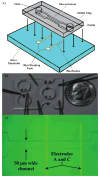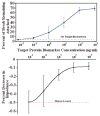Electrical detection of protein biomarkers using bioactivated microfluidic channels
- PMID: 19417910
- PMCID: PMC2778468
- DOI: 10.1039/b818872f
Electrical detection of protein biomarkers using bioactivated microfluidic channels
Abstract
Current methods used for analyzing biomarkers involve expensive and time consuming techniques like the Sandwich ELISA which require lengthy incubation times, high reagent costs, and bulky optical equipment. We have developed a technique involving the use of a micro-channel with integrated electrodes, functionalized with receptors specific to target biomarkers. We have applied our biochip to the rapid electrical detection and quantification of target protein biomarkers using protein functionalized micro-channels. We successfully demonstrate detection of anti-hCG antibody, at a concentration of 1 ng ml(-1) and a dynamic range of three orders of magnitude, in less than one hour. We envision the use of this technique in a handheld device for multiplex high throughput analysis using an array of micro-channels for probing various protein biomarkers in clinically relevant samples such as human serum for cancer detection.
Figures





References
-
- Cristofanilli M, Hayes DF, Budd GT, Ellis MJ, Stopeck A, Reuben JM, Doyle GV, Matera J, Allard WJ, Miller MC, Fritsche HA, Hortobagyi GN, Terstappen LWMM. J Clin Oncol. 2005;23:1420–1430. - PubMed
-
- Norppa H. Toxicol Lett. 2004;149:309–334. - PubMed
-
- Rifai N, Gillette MA, Carr SA. Nat Biotechnol. 2006;24:971–983. - PubMed
-
- Catalona WJ, Partin AW, Slawin KM, Brawer MK, Flanigan RC, Patel A, Richie JP, deKernion JB, Walsh PC, Scardino PT, Lange PH, Subong ENP, Parson RE, Gasior GH, Loveland KG, Southwick PC. JAMA. 1998;279:1542–1547. - PubMed
-
- Crowther JR. The ELISA Guidebook. Humana Press; Totowa, NJ: 2001.
Publication types
MeSH terms
Substances
Grants and funding
LinkOut - more resources
Full Text Sources
Other Literature Sources

